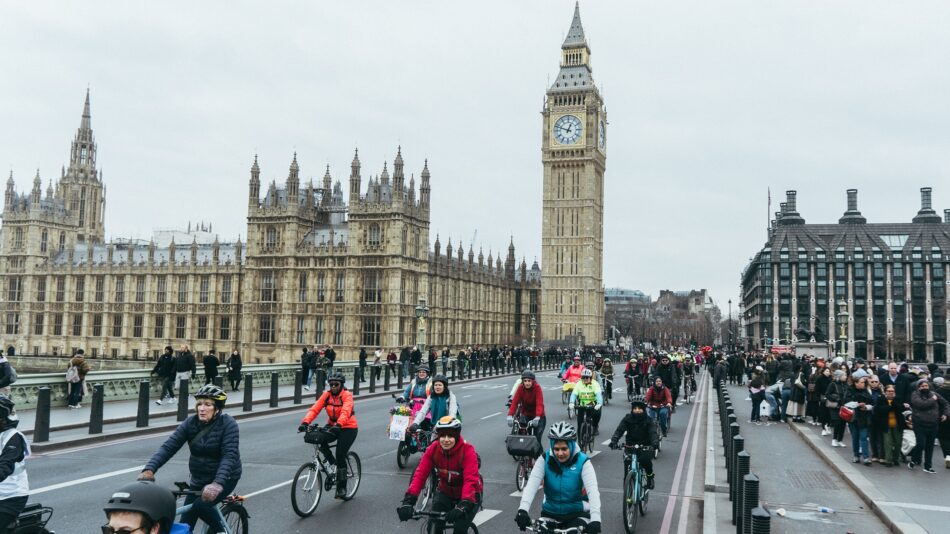

The big news from the latest TfL Travel In London annual overview report, is that cycling rates in London continue to rise rapidly. Cycling in 2022 is estimated to comprise circa 4.5 percent of all journeys made daily (‘mode share’) up from 3.6 percent in 2019 and the number of “stages” cycled has risen since then too. 1.26 million “stages” daily in 2023 so far, up from 1.19 million in 2022, and a 20 percent rise since 2019, despite huge changes to travel patterns post-pandemic, and lower levels of commuting across modes.
Cycling, as the report makes clear, is a mainstream mode of transport in London now. Other recent figures have shown that circa a quarter of Londoners already cycle here with some regularity, and a similar proportion want to cycle. So half of London wants to or already does cycle. The 1.26m stages cycled daily is the equivalent of about a third of the trips on the entire tube network happening daily, or about a quarter of trips done on the bus network.
This is, as many involved in transport in London were keen to tell us, very much down to London Cycling Campaign work over years to ensure rollout of safe cycle routes into an increasing number of London boroughs. We’ve campaigned for London to build cycling infrastructure, and the results are that Londoners now increasingly love cycling here.
Notably, the growth in cycling of late has come from inner London, and to a lesser extent, outer – compared to central. Central London cycling stages grew 1.7 percent between 2022 and 2023, but by 8.2% in inner London, and 5.5 percent in outer. One obvious conclusion would be that changed commuting patterns has hit central London (which is still mostly far too hostile for cycling as well) harder, but where the majority of cycle infrastructure has been delivered, that’s where most growth has been.
The results underline the real need for TfL and the boroughs to deliver a true, joined-up network of safe cycle routes that are far denser in central London (where huge gaps, Kensington & Chelsea, continue) and that reaches out into outer London too. And indeed, for that network to also in outer London join town centres, amenities and transport hubs to residential areas.
Indeed, what is notable also here is that while the diversity of cycling in London continues to be an issue, the growth in cycling is increasingly seeing people of colour catching up on cycle rates with white cyclists (women, older, Black and Asian and poorer Londoners continue to be underrepresented). As safe cycle routes roll out – cycling grows across the board, but particularly it’s growing for those impacted most by a lack of safe cycle infrastructure.
We can’t just disband LCC and go pop a few Champagne corks quite yet though – the campaigning work we’re doing has if anything more urgency than ever now, given the threats ranged against further delivery. The ‘easy wins’ on cycling are increasingly behind us.
The bad news, that goes hand in hand with broadly great news, is that despite recent gains, the Mayor, TfL and boroughs are being far too timid and are moving far too slowly to deliver on their own promises for a Net Zero carbon emissions roads transport system by 2030 (meaning a cut of 27% of road km driven pre-pandemic by then), and of a ‘Vision Zero’ of no fatal or serious road collisions by 2041. (And fairly obviously, we believe strongly that ‘Vision Zero’ needs bringing forward – we can’t accept another two decades of the impacts of such collisions!)
The Mayor’s Transport Strategy demands that 80% of London journeys are made by public transport, walking or cycling by 2041, yet the pre-pandemic figure was 63.6 percent in 2019 and was 62.3 percent in 2022. So we’ve gone backwards on overall sustainable mode share of late. While this is largely due to changes in public transport use post-pandemic, the reality is that to get to the 80 percent target or to cut road km driven by 27 percent by 2030 is a mountain climb that’s being treated as a gentle amble round the park.
Unsurprisingly the latest TfL report shows carbon emissions from roads transport way off target, and rising rather than falling as we return to ‘normal’. The report says with some understatement that while TfL is “broadly on track to meet the original 2050 ambition [on Net Zero], urgent and large-scale action at all levels of Government is needed to meet the accelerated 2030 target.”
Similarly, for ‘Vision Zero’ and road danger reduction, the 2022 target for the Mayor and TfL was a reduction of 65 percent of serious and fatal collisions compared to the 2005-09 baseline, but London has only seen a 38 percent reduction. Yes, the rise of active travel since 2005 will make any Vision Zero target ‘harder’ to achieve – lots more people cycling will naturally tend towards more collisions – and relative ‘risk’ is down compared to the numbers of those cycling and walking. But this is far from bold enough action – and it has meant people’s lives lost and ruined, with little sign to an end soon.
Outer London is an increasing focus for London Cycling Campaign, as schemes start to spread significantly outside of inner London. What’s marked here is that even in car-dominated boroughs, the return post-pandemic to motor traffic is not as bad as it is outside London. That said, there is clearly a huge variance in how outer London is treating active travel now visible. While active and sustainable modes account for between 70 to 87 percent mode share depending on the inner London borough, the range in outer London is between 39 to 73 percent.
It is undeniable that some outer London boroughs are far less dense, and indeed have far sparser public transport options. But these are also commonly boroughs where politicians have for decades chosen to do next to nothing to address these and other issues – and indeed have launched legal actions of late to try and stop any action happening.
Top of the tree for mode share is Waltham Forest, legendary for its action on active travel, followed by leafy Richmond Upon Thames. But even there, the new Travel in London report shows huge variance between modes. But overall these two manage to be outer London boroughs that outperform Newham in inner London (the lowest performing inner London borough), with City followed by Hackney and Westminster being the best-performing inner London boroughs.
The key element for cycling to grow is a network of joined-up safe routes – and again, while the good news is that the ‘Strategic Cycling Network’ of TfL signed-off routes that meet their quality criteria is expanding, it’s not doing so quickly enough. TfL’s target is that 40 percent of Londoners live within 400 metres of the network by 2030, only 24.2 percent do as of November 2023, but that is up from 21.9 percent in 2022 and just 5 percent in 2016. The expansion seen during Sadiq’s first term and the start of Covid needs to continue at pace.
The network exploded in size during the start of the pandemic but since then progress has slowed, partly due to government funding being very patchy, but also due to a lack of boldness and will to deliver schemes in the manner and with the rapidity seen during the first months of the pandemic. But that is a real issue if the Mayor’s targets are to mean anything. Either the Mayor will need to deliver more funding to active travel somehow, or the alternative is deliver bolder schemes more rapidly and cheaply using the temporary materials and approach taken during the start of the pandemic. Both approaches, however, will require a lot more internal coherence at TfL.
One of the biggest issues impacting delivery of the cycle network right now is TfL’s own internal incoherence and timidity – primarily, it appears, driven by concern around TfL Buses and journey times. There has long been a strong correlation between bus journey times, reliability and ridership (and from ridership, revenue). As a result, and particularly since TfL’s post-pandemic battles over funding with the government, LCC has heard over and over again of active travel schemes that could have any possible impact on buses being watered down, delayed or just cancelled. But the latest Travel in London report makes it clear that active travel schemes are not the big issue here – and indeed, can be part of the solution.
Congestion on London’s roads, according to the report has remained far below pre-pandemic levels, and indeed the report shows that congestion levels soared prior to the introduction of most of the current network of safe cycle routes. Since the pandemic, average bus speeds have increased. The report then goes on to say that bus speeds are improved by “giving buses priority through techniques such as technology to optimise traffic signal cycles, infrastructure such as dedicated bus lanes for some or all of the day, bus gates or by operating limited-stop services.”
Bus gates, such as seen in some Low Traffic Neighbourhoods, on Bishopsgate, at Bank, on Stoke Newington Church Street etc. have been primarily championed by boroughs and TfL teams associated with active travel – not by TfL Buses – rather strikingly. If TfL starts delivering more bus gates, they’ll be a win-win for cycling and public transport. But either way, the report is clear on the need for a lot bolder action on public transport, cycling, walking, wheeling and reducing unnecessary use of motor vehicles across London. And that the result of action is working. Now we need a lot more, bolder schemes delivered quicker and a lot less internal politicking inside TfL. TfL’s own data, in this report, makes that case strongly. Build it, and they are coming.
As ever, of course, LCC will continue to campaign to resolve these hold-ups at TfL, to push the Mayor to commit to more cycling and accelerating the active travel revolution taking place across London too patchily and slowly, and to ensure everyone who wants to can cycle in our capital city.

Become a member
The best way to support our work making London better for cycling is to join us as a member. You'll be joining over 12,000 other Londoners calling for cycling to be made safer and more enjoyable in every borough. Join today to make your voice heard and receive a host of great benefits.
Keep up to date
